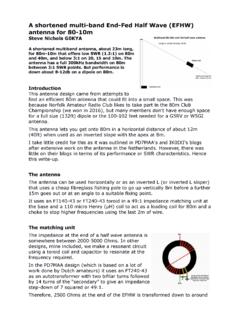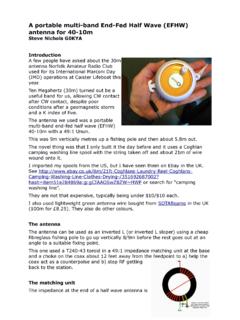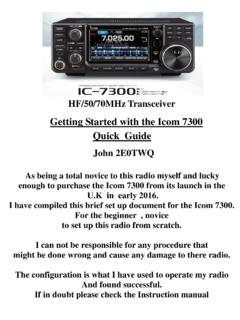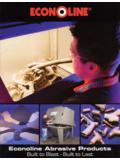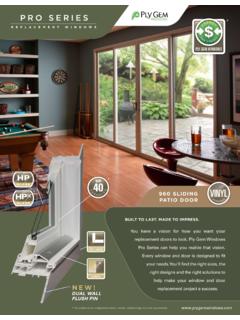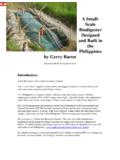Transcription of The mystery of GM3HAT's Crossed Field Loop (CFL) Antenna
1 The mystery of GM3 HAT's Crossed Field Loop (CFL) AntennaNow it can be told how were they built and what was Maurice working on before he died?It was with regret that I learned that Maurice Hately GM3 HAT (and latterly G3 HAT) had passed away. It appears that he actually died in the spring of 2012, but there was no mention of it in the radio interest in Maurice's work stems from my enthusiasm for small and stealthy HF antennas. As one of the pioneers of the very controversial Crossed Field Antenna (CFA) theory, Maurice used to make and sell small loops for everything from Top Band to 6m. His adverts regularly appeared in RadCom and I was lucky enough back in 2002 to review some of them for the ! This was on the strict understanding that I didn't reveal how he had configured the matching even had to promise not to break the seals on the boxes.
2 This I duly did and the review was written and the original RadCom review of the Crossed Field loop antennas. As you will see I was not terribly impressed by the multiband version, although the 20m and especially the 40m version worked very well. In fact, the 40m version surprised me as it was very lively is how Maurice said it worked: This Antenna is the latest form of Crossed Field Antenna . The electromagnetic waves are created within the small Field Interaction Zone around the two conductors of the loop. The new process of Poynting Vector Synthesis we have recently invented is the electrical dual of the system we used with success in the voltage stimulated forms of CFA Ref GB Patent 2 215 524 etc and papers in Electronics World March '89 and Dec '90 plus IBC Amsterdam '97 IEE Conf. Publn 447 pp421-6. The CFL 7 is tuned internally to transmit 100W anywhere within the 40 metre amateur band.
3 There are no user adjustments. The SWR when fed by 50 Ohm coax is less that 1 over the UK 7 MHz band. If it is necessary to operate in the USA band an ATU will correct any small error. He also recommended 14m of coax or any multitude of 14m , shortly after the review came out Maurice telephoned me and was livid that someone had published details of the matching circuit on the internet and he accused me of leaking the information. It wasn't me, although I knew who it was who had (in fact, that person sent me the diagram himself). Sadly, that gentleman has also subsequently died. The details were taken down and never seen again until promised Maurice that I would keep his secret, and so I have for more than 10 years. But now that he is dead I feel that the information on how the antennas were built should pass into the public domain so that Antenna enthusiasts can try the design for themselves, debunk it or perhaps even improve on here it is the design for the GM3 HAT Hately 40m Crossed Field Loop is the schematic that was sent to me and here are a few words of matching unit/power splitter is wound on a Red (mix 2) toroid.
4 A suitable version might be a wiring is self variable capacitor brings the whole thing to resonance and in the production models it was replaced by a length of RG58 coax. This has a capacitance of around per foot. I would suggest using a variable capacitor when building the Antenna and replacing it with coax once you have the correct values. From the diagram the suggestion is that it is less than 60pF for the 40m version and probably lower still for the 20m loop was actually made from copper brake pipe, but could just as easily be made from RG13 coax. The loop for the 40m version was 40cm in diameter. For the 20m version it was 30cm in diameter. The 20m version used RG58 coax for the you can see there was a small coil consisting of of a turn of copper wire about inch diameter between the inner and outer of the should be enough information here for experimenters to build a working model of the 40m CFL and perhaps even the 20m experimental G3 HAT Radio Photon AntennaBut there was more!
5 About three years ago Maurice sent me a prototype of a twin loop CFL that he said completely got rid of the common mode induced currents on the coax outer. In other words it was balanced. He planned to get a patent on the design (I don't know if he ever did) and he said that the Antenna would silence his critics once and forever . He called it the Radio Photon Antenna .I tested the Antenna , but couldn't get the SWR down below about 4:1. One of the problems was that the copper brake piping had been cut to make it easier to pack and Maurice felt that this may have been the reason it didn't Antenna was returned to him at his request with the promise that he would work on it and send it back to me when complete I never heard from him for history's sake there is a schematic of what the Antenna looked like and how it was wired.
6 If anyone wishes to experiment with the Antenna design feel terms of construction details, the two loops were made of copper brake pipe with insulated copper wire down the middle. Each loop was about 60cm in toroid was a T200-2 (red with 26 turns in total, tapped at 13 turns and eight turns (or five from the far end).His detailed notes said that it worked like this: The feeder coax brings up from the TCVR a 50 Ohm signal (100W is OK, but I haven't tried any more it might over-flux the T200 toroid) which feed is used to create the required virtual magnetic photons (VMPs) from the loop's insides. The current traverses both loops , in sequence one turn at a time, rotating anti-clockwise in the left-hand loop then clockwise in the right hand loop, finally entering a five-turn tap on the autotransformer, which centre tap is the general circuit return path down the screen of the coax.)
7 The autotransformer anti-phase end (negative going voltage) is connected to a variable capacitor AND the outer screens of both loops . The current drawn away to this anti-phase end constitutes much of the capacitive current for resonating the autotransformer at the working frequency. The step-up turns ratio giving the number of primary turns (in this case 13)/input turns 5. Thus the secondary voltage is about times the input voltage on the feed. From memory the capacitor was a variable of about 150-300pF maximum. If anyone builds this or the original CFL I would like to hear from you. If I get time I intend to build the 40m CFL for myself to see how it whole Poynting Vector Synthesis debate goes on, with the focus now switched to the EH Antenna , which is a distant cousin of the original CFL don't wish to get into a debate as to how the antennas work, because they obviously do.
8 But I feel there is room for some experimentation for people who wish to find a small HF Antenna , especially if they would otherwise be off the G0 KYAJune 2013
